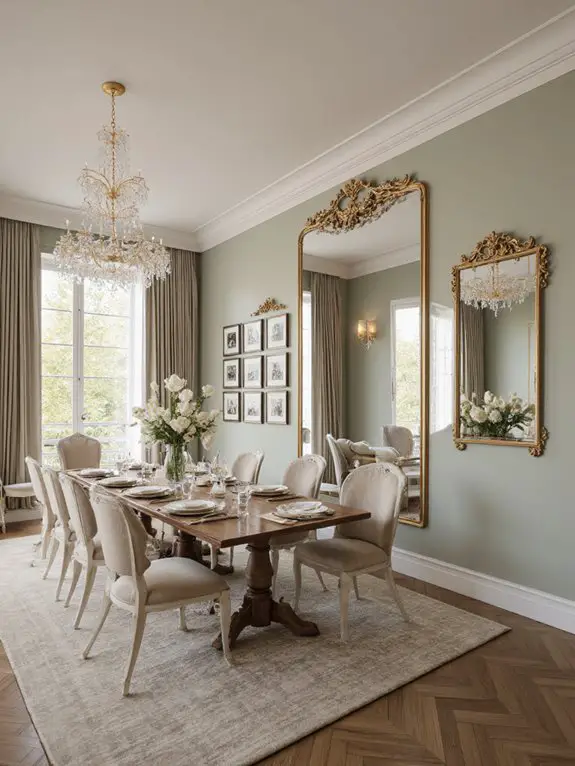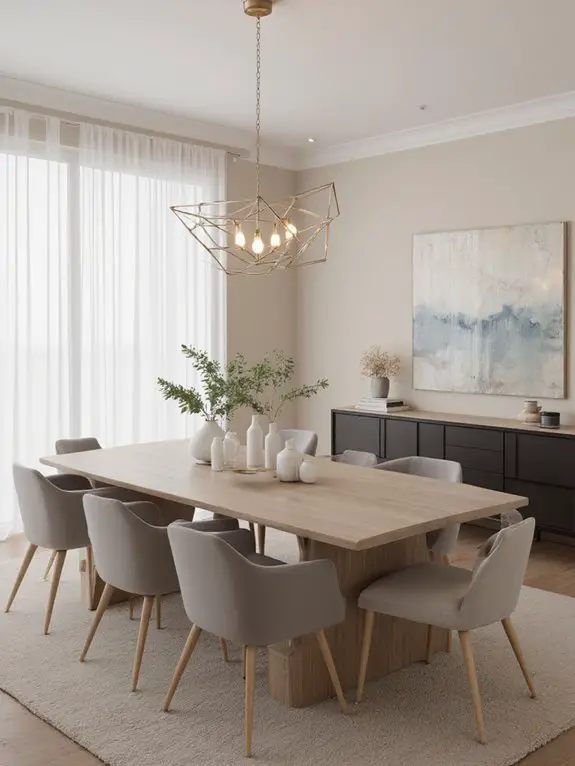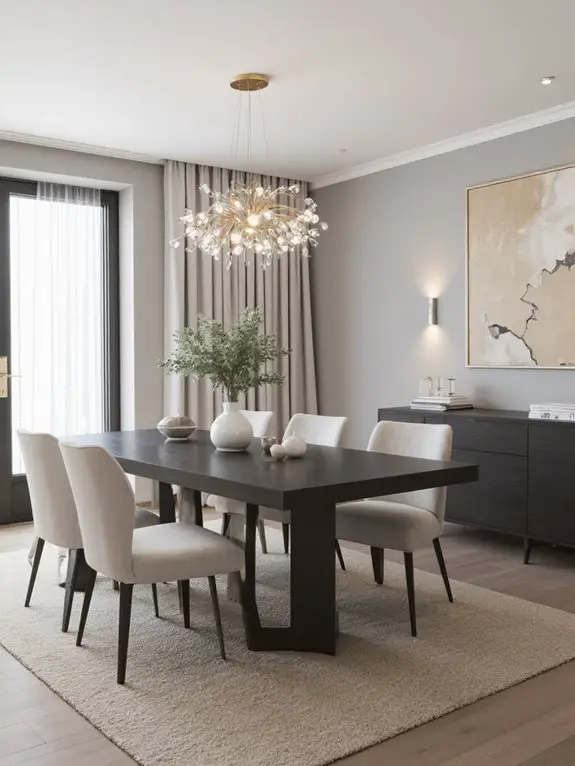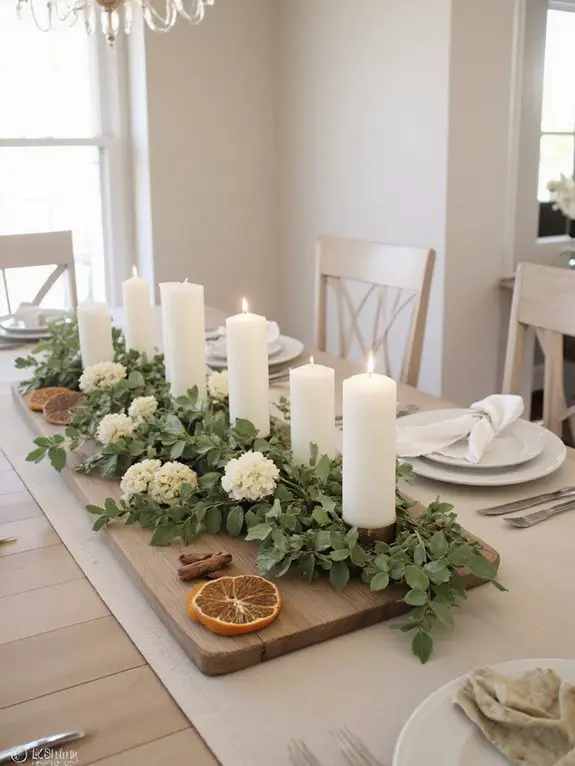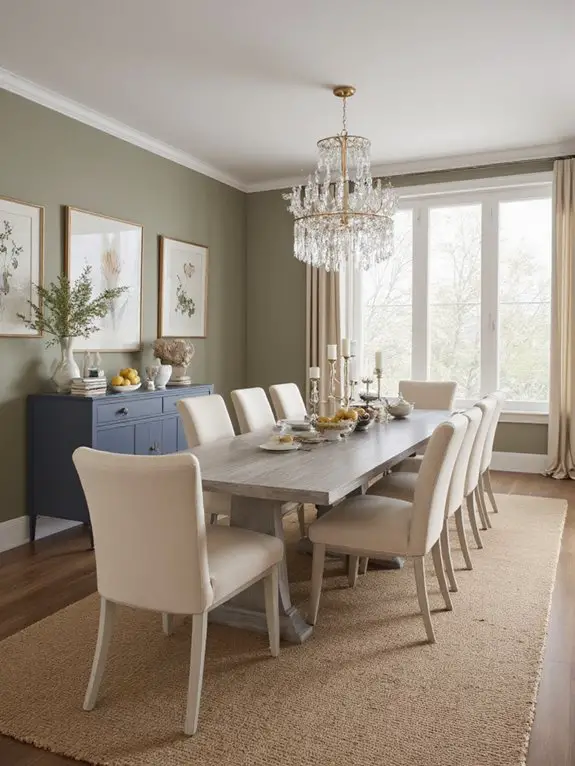I love the idea of using oversized abstract art or a gallery wall to create a bold focal point in my dining room. Mirrors enhance light and space, while textured wall panels add depth. Modern shelving balances function and style, and macramé wall art brings bohemian charm. Pop art pieces inject energy, and metallic decor adds elegance. An eclectic wall collage mixes personal and artistic elements for a unique touch. Explore more ways to transform your dining space.
Oversized Abstract Art
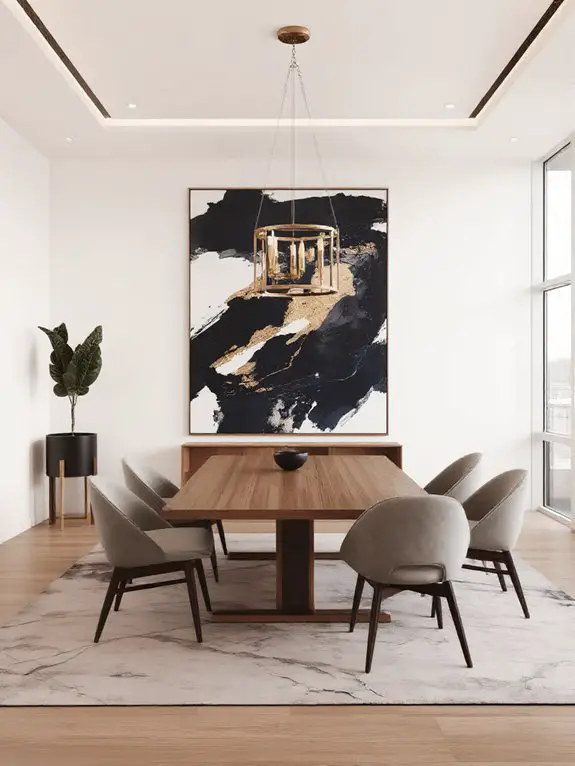
When it comes to creating a striking focal point in your dining room, oversized abstract art can transform the space with its bold presence. I’ve found that a large-scale piece above the dining table immediately draws the eye and sets the tone for the room.
Choose colors that complement your existing decor, but don’t shy away from vibrant hues to add energy. Positioning is key—center it at eye level to guarantee balance.
I prefer unframed canvases for a modern look or sleek frames for added sophistication. This approach not only enhances the aesthetic but also makes the dining area feel cohesive and intentional.
Gallery Wall
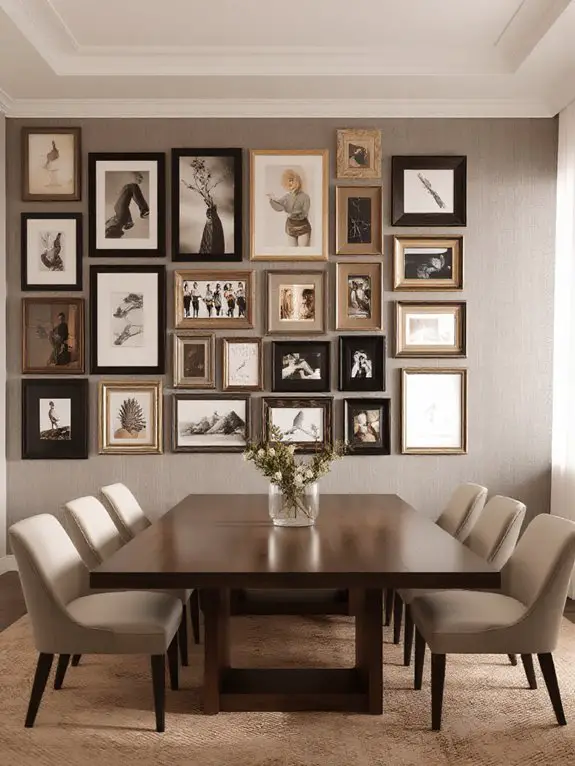
While oversized abstract art makes a bold statement, a gallery wall offers a dynamic alternative for those who love variety. I love how it lets me mix frames, sizes, and styles—family photos, vintage prints, and modern art—to create a personalized display.
Start by laying out your pieces on the floor to experiment with spacing and arrangement before hanging. Keep a consistent color palette or theme to tie everything together.
For balance, space frames evenly or group them in clusters. A gallery wall adds depth and personality, turning your dining room into a conversation starter that reflects your unique taste.
Mirrors for Added Depth
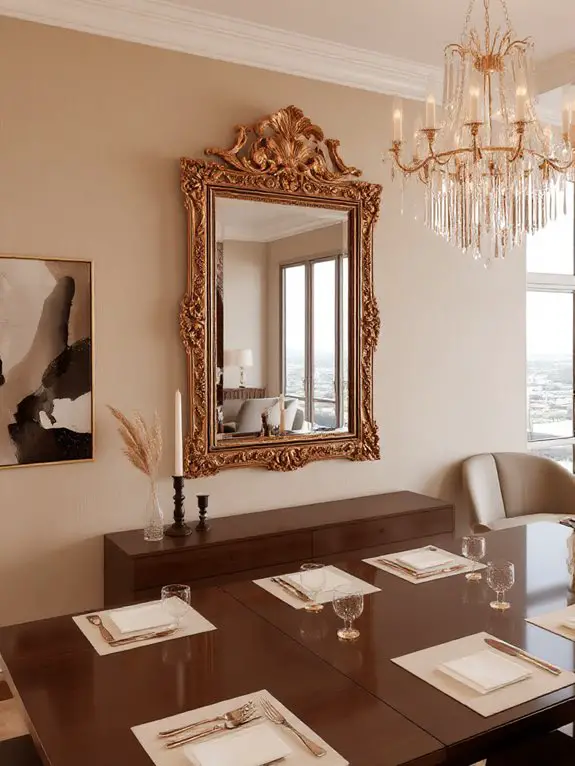
Mirrors can transform a dining room by creating the illusion of more space and enhancing natural light. I love using large mirrors to make smaller dining areas feel more open, especially when placed opposite a window to reflect outdoor views.
For a bold statement, I’ll opt for ornate or uniquely framed designs that double as art pieces. Lean a floor mirror against the wall for a casual, modern look.
Positioning mirrors strategically can also highlight key features, like a chandelier or artwork, amplifying their impact. When choosing a mirror, I make certain it complements the room’s scale and style for a cohesive, polished finish.
Textured Wall Panels
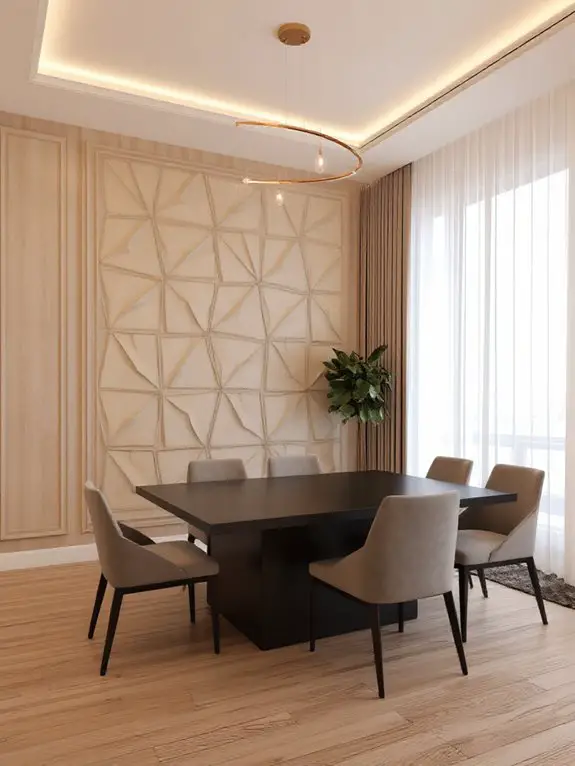
Adding textured wall panels to a dining room can instantly elevate its aesthetic while introducing depth and character. I’ve found that materials like wood, plaster, or 3D tiles create a focal point that draws the eye and transforms the space.
For a cozy vibe, I recommend reclaimed wood panels, while geometric designs offer a modern edge. Textured panels also mask imperfections, making them practical *and* stylish.
When choosing a finish, consider the room’s lighting; matte textures soften harsh light, while glossier options reflect it. Pairing panels with neutral tones keeps the look balanced, letting the texture shine without overwhelming the room.
Modern Shelving
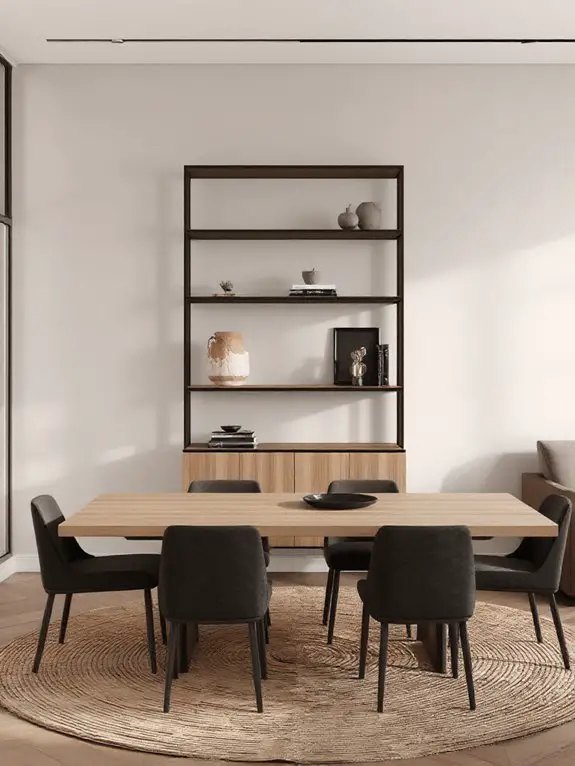
Modern shelving can serve as both a functional storage solution and a striking design element in your dining room. I often recommend choosing sleek, minimalist designs with clean lines to complement contemporary interiors.
Floating shelves made of materials like walnut, metal, or glass create an open, airy feel. I suggest arranging them asymmetrically for visual interest or in uniform rows for a polished look.
Use the shelves to display decorative items like sculptures, plants, or books, but avoid overcrowding. Matching the shelving’s finish to other furniture or accents ties the room together.
Proper installation guarantees stability, especially for heavier items, making them both practical and stylish.
Vintage Plates Display
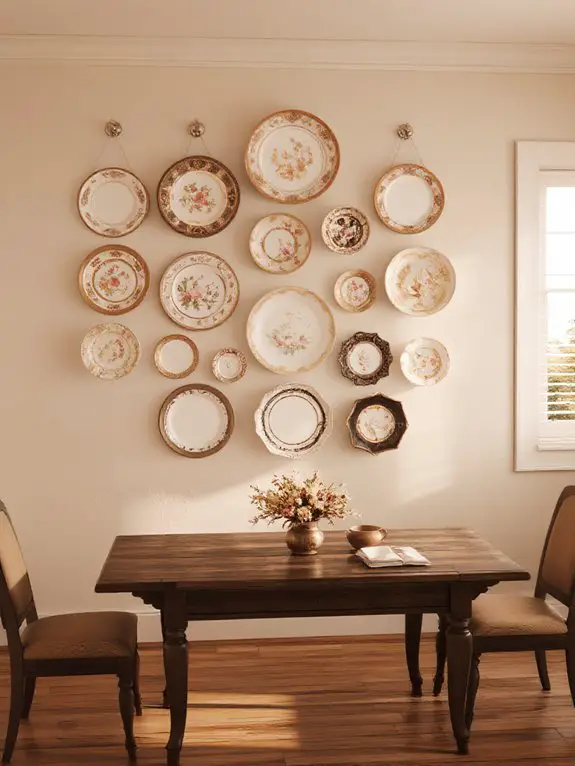
While modern shelving offers a sleek and functional aesthetic, showcasing vintage plates can infuse your dining room with timeless charm and character. I love arranging mismatched plates in a curated gallery wall, blending colors and patterns to create visual interest.
Start by selecting plates with complementary hues or shared motifs, and use plate hangers to secure them safely. I often group them in odd numbers for balance, spacing them evenly for a cohesive look.
Mixing textures, like porcelain and stoneware, adds depth. This approach not only highlights cherished heirlooms but also transforms your wall into a conversation-starting focal point.
Statement Wallpaper
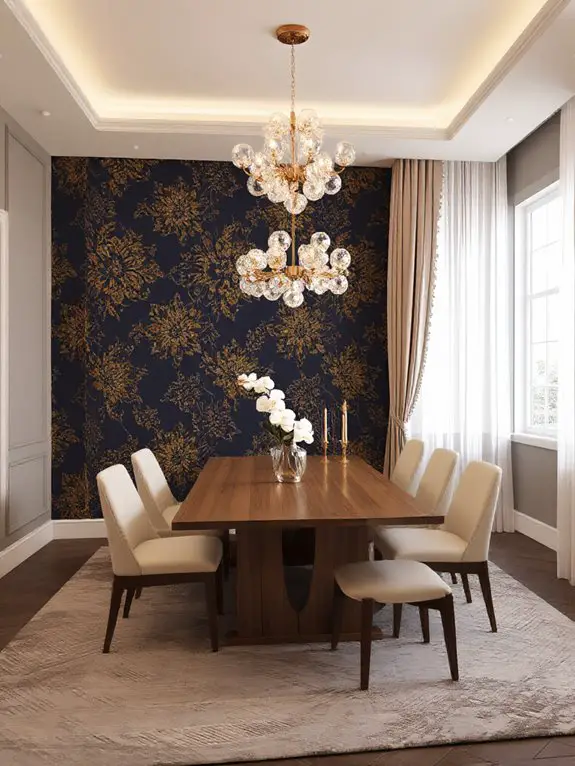
Though often overlooked, statement wallpaper can dramatically elevate the ambiance of your dining room by introducing bold patterns, rich textures, or striking colors. I recommend choosing a design that complements your furniture and decor style, whether it’s a modern geometric print or a classic floral motif.
Opt for high-quality, durable materials, especially in a dining space where spills might occur. Consider an accent wall to avoid overwhelming the room, and pair it with neutral tones for balance.
Peel-and-stick options are great for renters or frequent updaters. Remember, the right wallpaper can transform your dining area into an enthralling focal point.
Floating Shelves
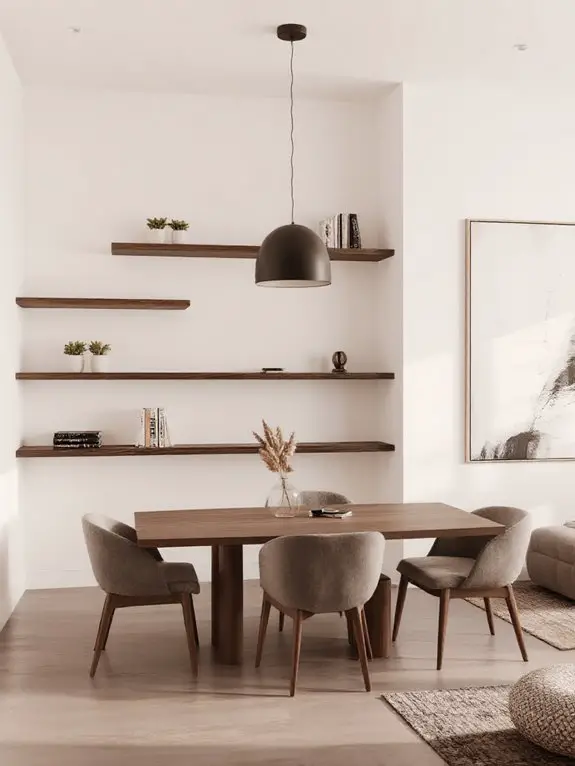
Since floating shelves offer both functionality and aesthetic appeal, they’re an excellent solution for adding storage and style to your dining room. I love how they create visual interest without overwhelming the space, especially when styled with a mix of decorative and practical items.
Opt for wood or metal finishes that complement your dining table or chairs for a cohesive look. Keep the arrangement balanced—group smaller objects in odd numbers and leave breathing room between pieces.
For a modern touch, try asymmetrical placements. Just make sure shelves are securely mounted, as they’ll hold delicate dinnerware or cherished decor.
Maps and Globes
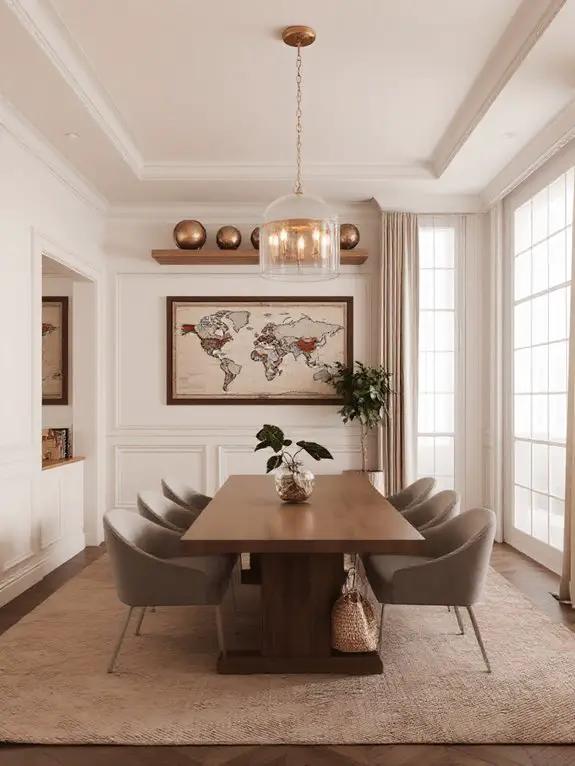
If you’re looking to add a touch of global sophistication to your dining room, maps and globes can serve as both decorative and educational focal points. I love using a large vintage map as a statement piece above the dining table—it instantly draws the eye and sparks conversation.
A sleek, modern globe placed on a sideboard or shelf adds depth and a sense of exploration. For a more artistic approach, consider framed cartographic prints or a world map mural.
These elements not only enhance the room’s aesthetic but also inspire curiosity about different cultures and destinations, making your space feel worldly and inviting.
Rustic Wood Accents
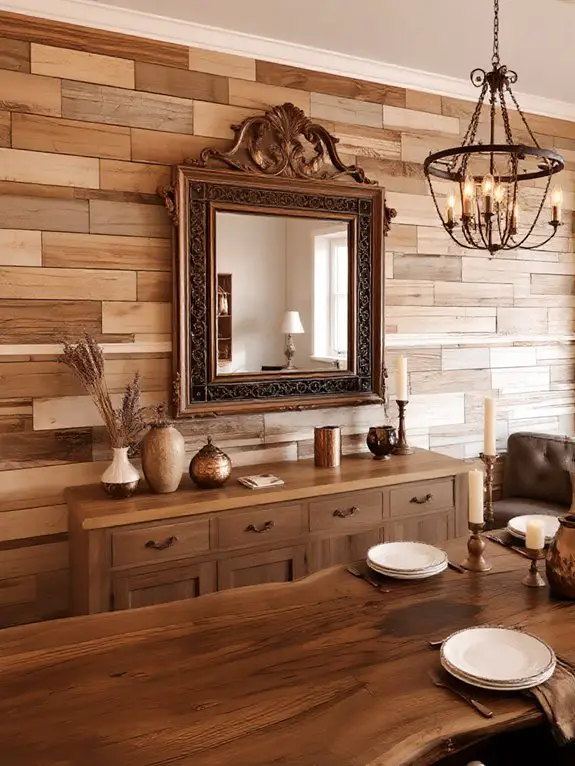
Incorporating rustic wood accents into your dining room can instantly infuse warmth and character into the space, making it feel both cozy and timeless. I love using reclaimed wood shelves or a weathered timber feature wall to create a focal point that draws the eye naturally.
Pairing these elements with neutral tones or soft textures enhances the rustic vibe without overwhelming the room. A wooden ceiling beam or a simple, hand-carved wooden plaque can add subtle charm.
I always guarantee the wood’s finish complements the dining table or chairs, creating harmony. These touches bring a sense of history and natural beauty, elevating the entire atmosphere.
Metal Wall Sculptures
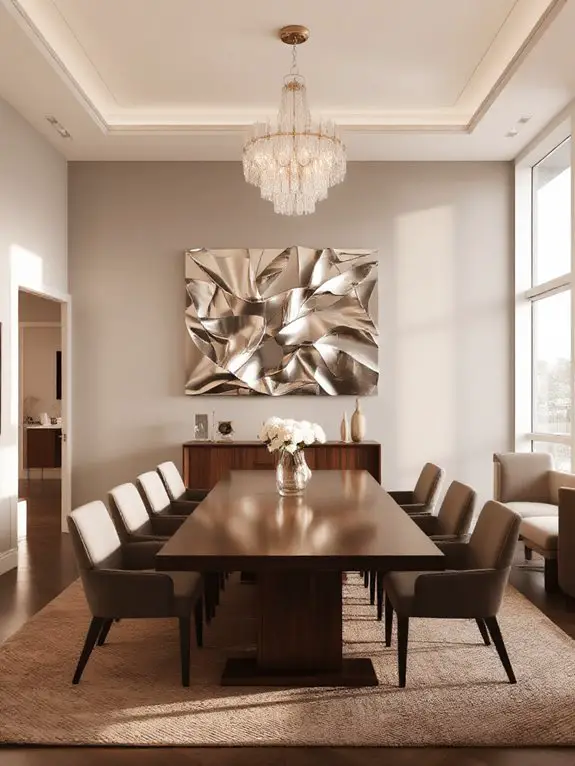
While rustic wood accents bring warmth, metal wall sculptures introduce sleek contrast and modern sophistication to a dining room. I’ve found that choosing pieces with geometric shapes or abstract designs can create a focal point, drawing the eye and elevating the space.
Metal sculptures reflect light beautifully, adding depth without overwhelming the room. Opt for finishes like brushed steel, copper, or black iron to complement your existing decor.
I prefer placing them above a buffet or console table to enhance symmetry. Remember to balance their weight with lighter elements, like mirrors or soft textures, to maintain harmony in the overall design.
Typography Art
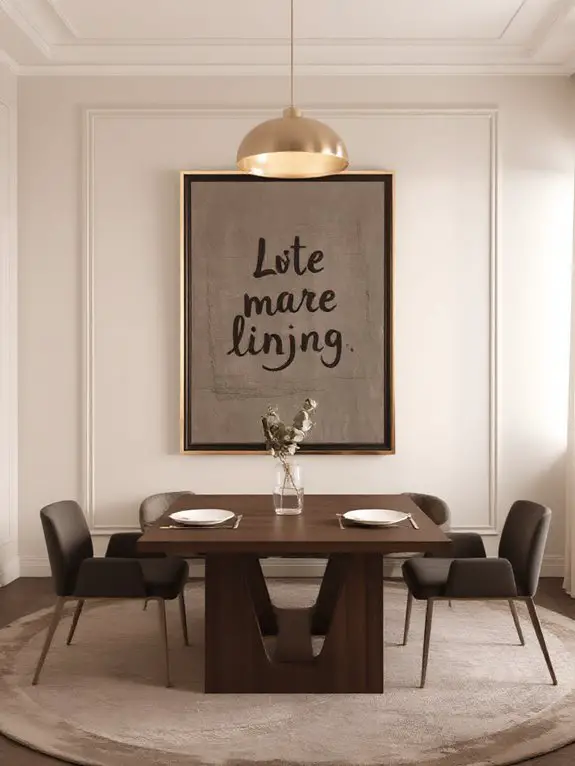
Typography art offers a striking way to infuse personality and meaning into a dining room’s decor. I love how bold lettering or elegant scripts can transform a blank wall into a focal point, whether it’s a favorite quote, a family name, or a single impactful word.
Choose fonts that match your style—modern sans-serifs for a sleek look or ornate scripts for classic charm. Consider size and placement; oversized pieces make a statement, while smaller ones work well in groupings.
Opt for high-quality materials like wood or metal for durability. Keep colors cohesive with your palette to maintain harmony in the space.
Nature-Inspired Murals
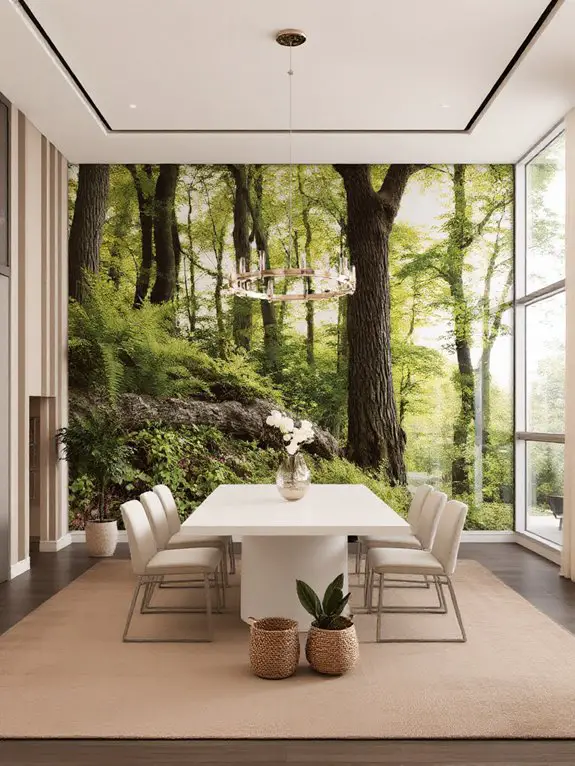
Nature-inspired murals can instantly transform a dining room into a serene retreat, bringing the calming beauty of the outdoors inside. I’ve found that choosing a mural with lush greenery, blooming florals, or tranquil landscapes creates a soothing atmosphere perfect for dining.
Opting for muted tones like soft greens, blues, and earthy browns enhances the natural feel without overwhelming the space. Positioning the mural on a focal wall guarantees it becomes the room’s centerpiece.
I recommend pairing it with minimalistic decor, like wooden furniture or neutral tableware, to let the mural shine. This approach creates a harmonious balance between nature and modern design.
Ceramic Tiles
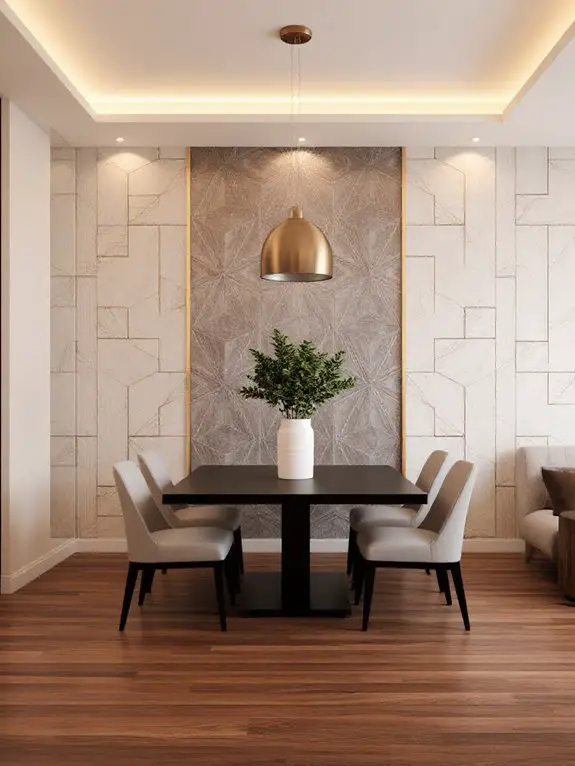
If you’re looking to add texture and durability to your dining room walls, ceramic tiles offer a versatile solution that combines style with practicality. I’ve found that they’re perfect for creating a polished look while being incredibly easy to clean, especially in a space prone to spills.
You can choose from glossy finishes for a sleek vibe or matte options for a more subtle effect. Tiles with intricate patterns or geometric designs can act as a focal point, while monochromatic styles blend seamlessly into your decor.
Plus, their durability guarantees they’ll withstand daily wear and tear effortlessly.
Black and White Photography
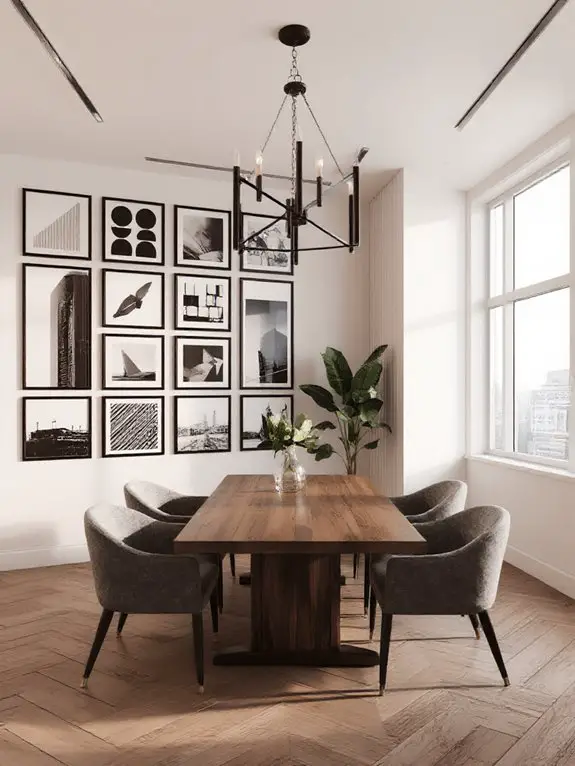
While black and white photography might seem like a classic choice, it’s also a timeless way to elevate your dining room decor. I love how it adds sophistication and depth without overwhelming the space.
Opt for large, framed prints of landscapes, portraits, or architecture to create a striking focal point. Mixing different sizes and frame styles can add visual interest, but I’d suggest sticking to a cohesive theme to maintain harmony.
Matte finishes on your prints reduce glare, making them easier to appreciate during meals. This approach guarantees your dining room feels both elegant and inviting, with a touch of artistic flair.
Geometric Patterns
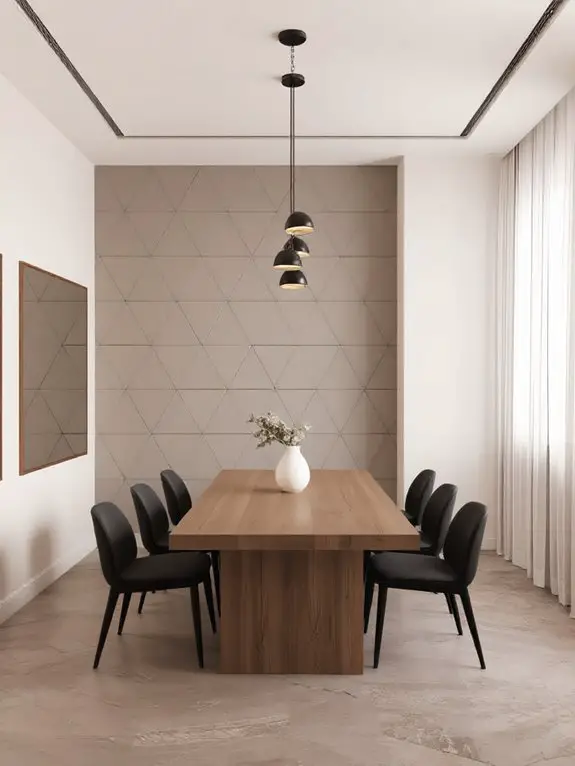
Geometric patterns bring a modern and dynamic energy to dining room walls, offering an invigorating alternative to traditional decor. I love how they create a sense of movement and depth, transforming a plain wall into a focal point.
Whether it’s bold, contrasting shapes or subtle, repeating designs, geometric patterns can suit any style, from minimalist to eclectic. I often experiment with wallpaper, decals, or even painted murals to achieve this look.
The key is balance—pairing geometric walls with simpler furnishings guarantees the room feels cohesive, not overwhelming. This approach adds personality and depth, making every meal feel like a stylish event in a space that’s uniquely mine.
Oversized Clocks
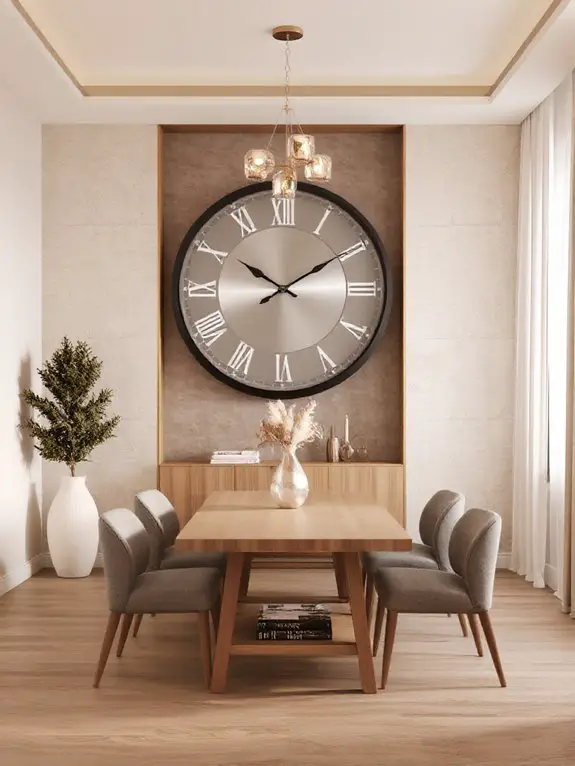
When I’m looking to make a bold statement in a dining room, oversized clocks are one of my go-to choices. They’re not just functional; they serve as striking focal points that add elegance and drama.
I lean toward minimalist designs with clean lines or vintage styles with ornate details, depending on the room’s aesthetic. Placement is key—I position them above a buffet or console table to anchor the space.
Metallic finishes like gold or silver can elevate the ambiance, while muted tones work beautifully in more subdued settings. Their sheer scale demands attention, transforming walls into mesmerizing statements effortlessly.
Woven Wall Hangings
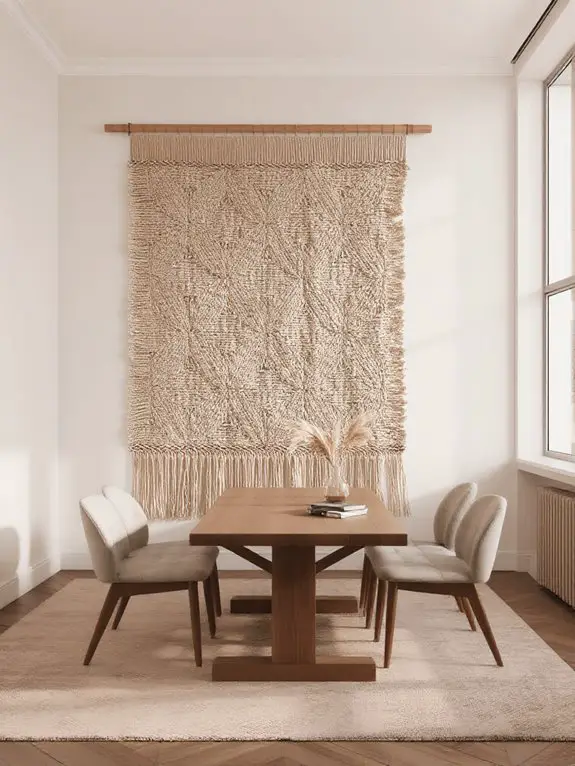
Woven wall hangings bring texture and warmth to dining room walls, offering a versatile and tactile alternative to more traditional decor. I often choose pieces with neutral tones to complement existing furniture, but bold patterns can make a striking statement.
Materials like wool, cotton, or jute add depth and a natural element to the space. Hang them above a sideboard or as a central focal point to draw the eye.
I recommend selecting a size that balances the wall without overwhelming it. These hangings are easy to switch out, making them a flexible option for revitalizing the room’s aesthetic.
Chalkboard Wall
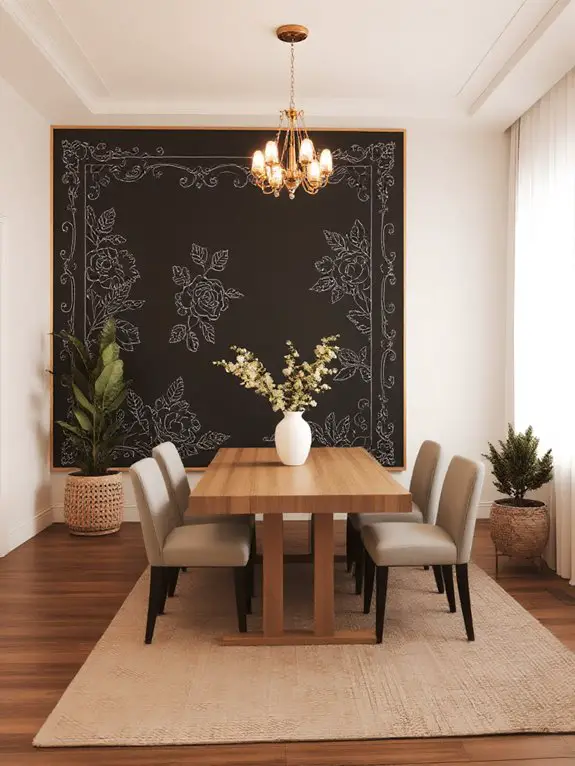
Adding a chalkboard wall to your dining room can instantly transform the space into a dynamic, interactive area that’s both functional and stylish. I’d choose a prominent wall or an accent area to paint with chalkboard paint, ensuring it complements the room’s overall design.
You can use it to write menus, inspirational quotes, or even let guests leave messages during gatherings. For a polished look, I’d frame the wall with wood or metal trim.
Don’t forget to keep chalk nearby for spontaneous creativity. It’s a practical yet artistic addition that personalizes your dining space effortlessly.
Minimalist Art
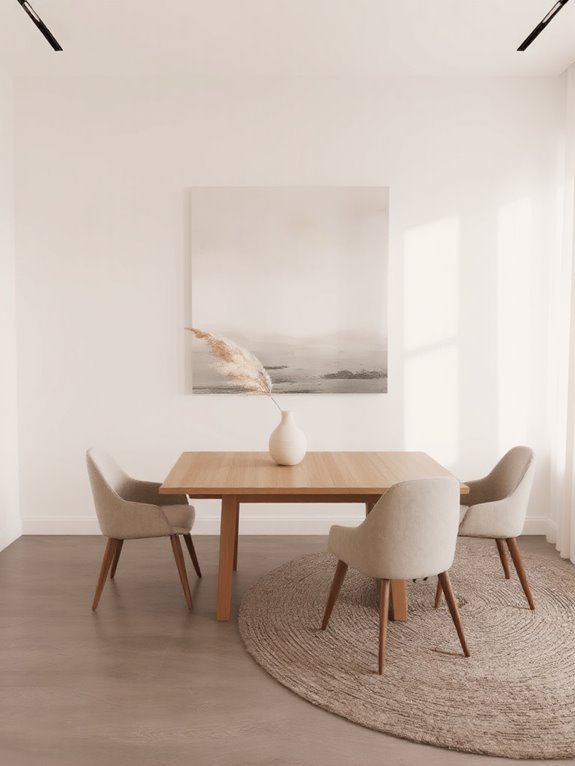
While chalkboard walls bring a playful and interactive vibe, minimalist art offers a clean, sophisticated contrast that can elevate your dining room’s aesthetic. I love using simple pieces with clean lines, neutral tones, or subtle textures to create a calm, uncluttered space.
For example, a single large-scale abstract painting or a series of small, framed line drawings can make a striking impact. Focus on quality over quantity—choose one or two focal pieces rather than overwhelming the wall.
Minimalist art pairs beautifully with modern or Scandinavian decor styles, enhancing the room’s harmony without distracting from the dining experience.
Color Blocking
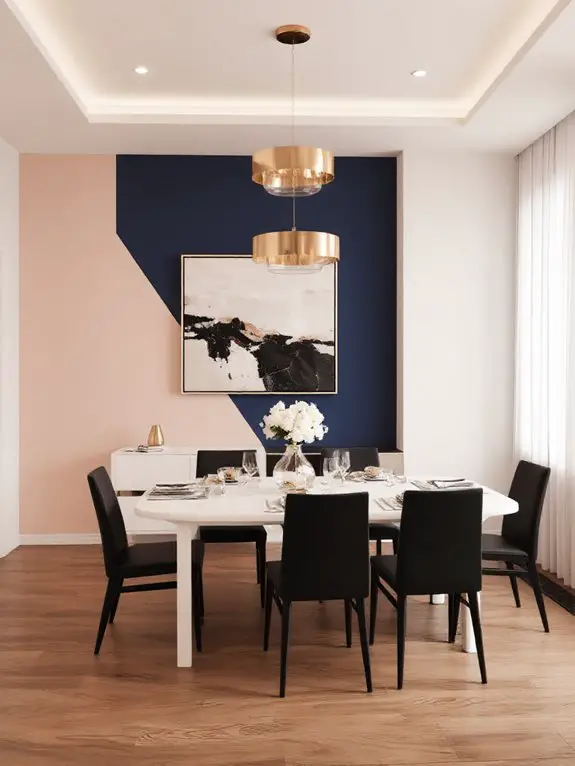
If you’re looking to make a bold statement in your dining room, color blocking can transform your walls into a vibrant focal point. I recommend choosing two or three complementary or contrasting colors to create dynamic geometric shapes or sections.
For example, pair deep navy with crisp white or soft blush with charcoal gray for a modern yet elegant look. Use painter’s tape to guarantee clean edges and consider the room’s lighting to enhance the colors’ impact.
This technique not only adds visual interest but also defines the space, making it feel more intentional and cohesive.
Macramé Wall Art
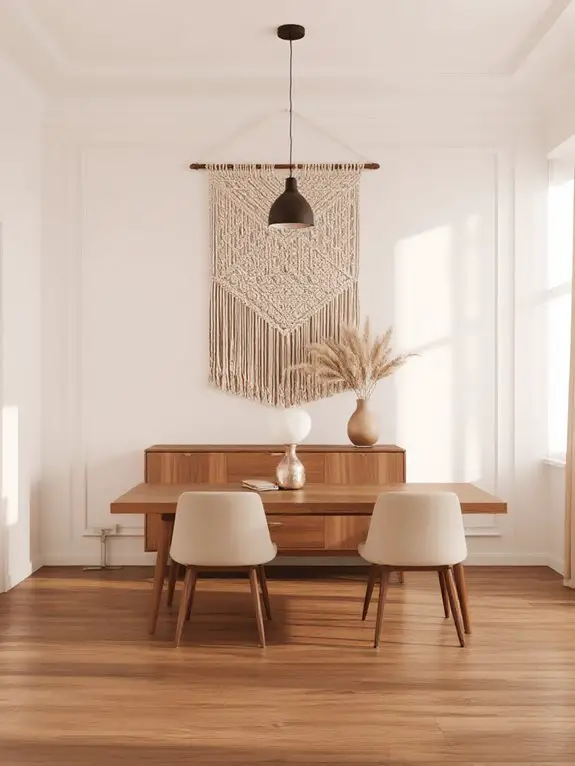
Macramé wall art introduces texture and warmth to a dining room, effortlessly blending bohemian charm with a modern aesthetic. I love how its intricate knots create visual interest without overwhelming the space.
Choose neutral tones for versatility or bold colors to make a statement. Hang a large piece above a buffet or mix smaller designs for a gallery effect.
The handmade quality adds a personal touch, perfect for cozy gatherings. Opt for natural fibers like cotton or jute to enhance organic vibes. Keep it dust-free with gentle vacuuming or spot cleaning. It’s an easy way to elevate your dining area with timeless artistry.
Pop Art Pieces
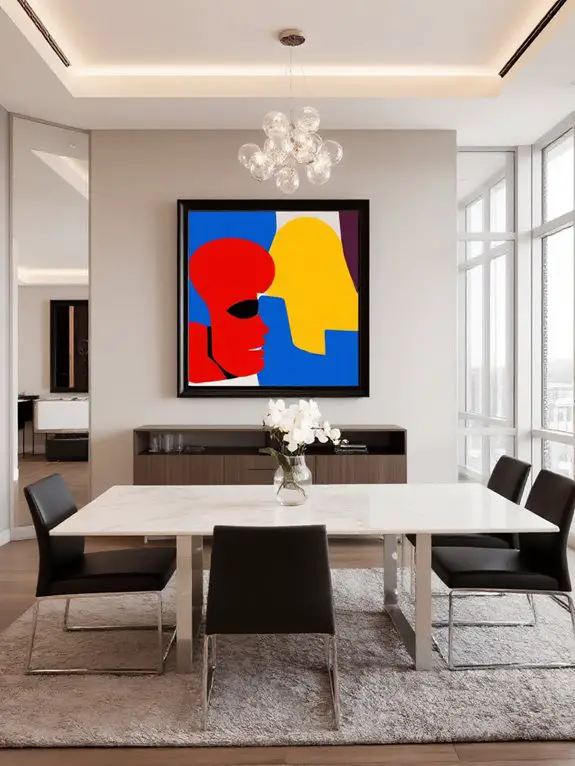
Pop art pieces inject vibrant energy and a touch of playful sophistication into a dining space, making them a striking alternative to more subdued decor. I like how bold colors, graphic patterns, and iconic imagery instantly draw the eye and spark conversation.
When choosing a piece, I consider the scale—larger works anchor a room, while smaller pieces can complement a gallery wall.
I also think about balancing the artwork with the room’s palette; a neon pop piece pairs beautifully with neutral tones. Opting for high-quality prints or originals guarantees durability and elevates the overall look, creating a dynamic focal point.
Metallic Wall Decor
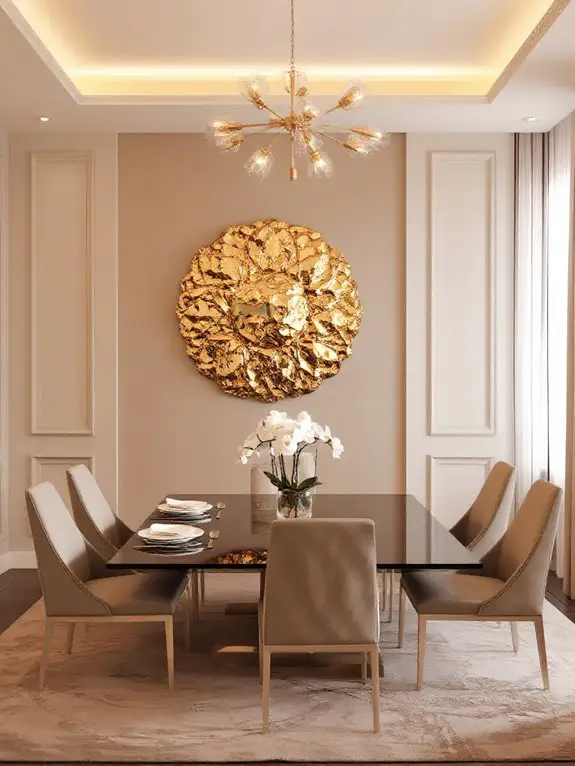
Since dining rooms often benefit from a touch of elegance, metallic wall decor can introduce a refined yet versatile accent to the space. I’d recommend incorporating gold, silver, or copper elements through framed mirrors, sculptural pieces, or textured panels to add depth and sophistication.
For a modern look, opt for geometric designs in brushed metal, while antique finishes can lend a timeless charm. When choosing metallic decor, consider the room’s lighting—natural light enhances the shimmer, while warm artificial lighting creates a cozy glow.
Keep the palette balanced; pair bold metallic accents with neutral walls to avoid overwhelming the space.
Eclectic Wall Collage
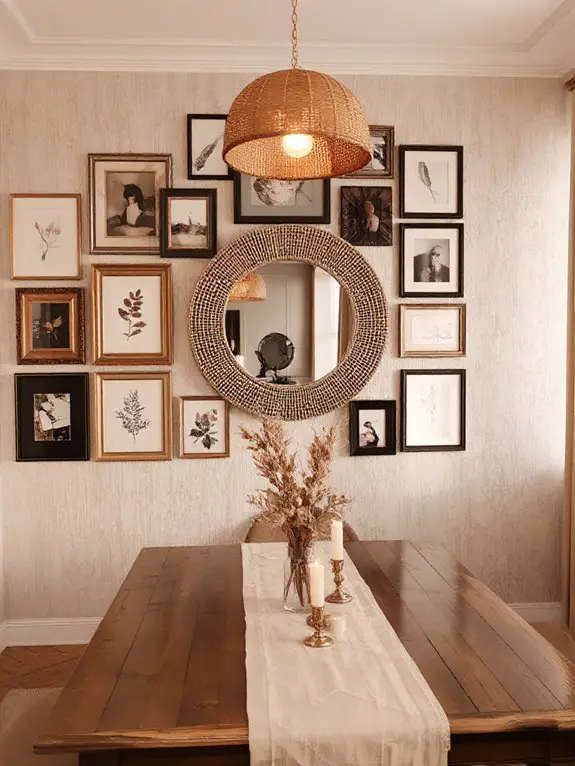
When creating an eclectic wall collage, I suggest starting with a mix of personal and artistic elements that reflect your style while maintaining visual harmony. Layer framed photos, vintage prints, and modern art pieces, ensuring they complement each other in color or theme.
I like to vary sizes and shapes to add depth, but I keep spacing consistent for balance. Incorporate textures like woven baskets or metal accents for added interest.
Don’t be afraid to mix mediums—canvas, wood, or mirrors can coexist beautifully. Finally, I always step back to assess the arrangement, tweaking until it feels cohesive yet dynamic.
Frequently Asked Questions
How Do I Choose the Right Lighting for My Dining Room Decor?
Choosing the right lighting for my dining room feels like setting the stage for a performance. I’ll pick a fixture that complements my table size, tie it to the room’s style, and dim it for mood flexibility.
What Colors Complement a Small Dining Room Wall?
I’d pick light, neutral tones like soft gray or creamy white to make my small dining room feel bigger. If I want warmth, I’d add a muted pastel or earthy tone—just enough color without overwhelming the space.
Can I Mix Different Decor Styles in One Dining Room?
I love mixing decor styles in my dining room; it adds depth and personality. I pair modern art with rustic wood or combine vintage mirrors with sleek lighting, ensuring colors or textures tie everything together seamlessly.
How Do I Protect My Walls From Damage When Hanging Heavy Decor?
I don’t want my walls to crumble like a sandcastle under pressure, so I always use sturdy anchors or toggle bolts for heavy decor. It’s like giving them armor to stand tall and protect their integrity.
What’S the Best Way to Clean and Maintain Wall Decor?
I dust my wall decor weekly using a soft microfiber cloth to avoid scratches. For deeper cleaning, I gently wipe with a damp cloth and mild soap, then dry immediately. I check for wear regularly to keep it looking fresh.

